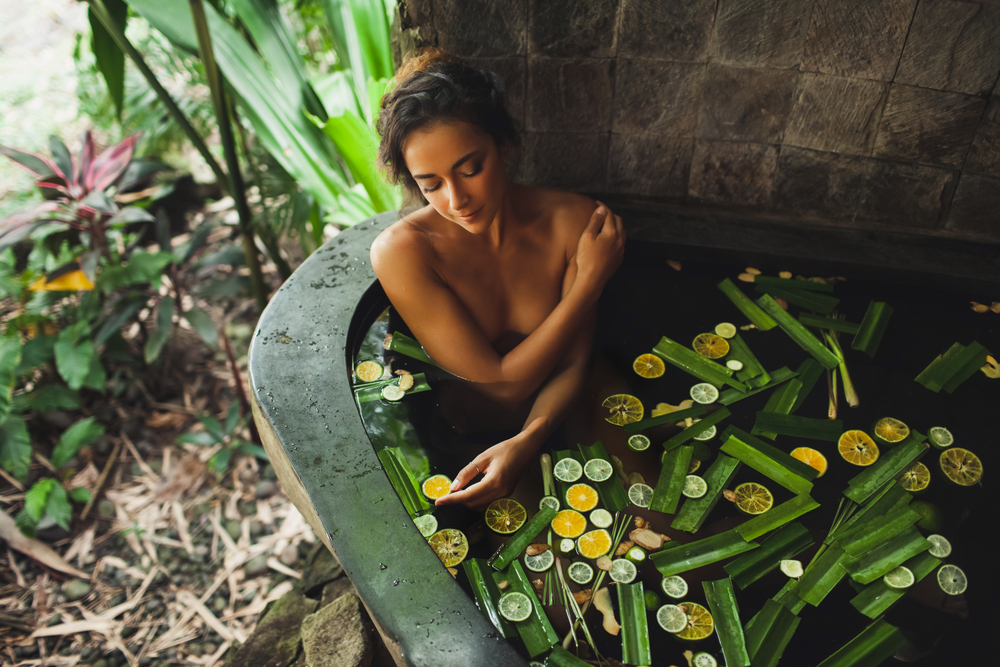
Is your skin looking dull, dry, and flaky? Here is how to enhance your natural glow with an Ayurvedic Aromatherapy Bath for Glowing Skin.
Ayurvedic Aromatherapy Bath Ritual for Glowing Skin
An ayurvedic aromatherapy bath is a perfect way to cleanse both the body and the mind at the same time.
Nowadays, we shower every day to meet the social standards of cleanliness and personal appearance. However, for Ayurveda, a bath means a whole lot more than just cleaning the skin and removing dead skin cells from the body.
Bathing is spiritual purification, a cleansing done for spiritual purposes. And by adding specific flowers and herbs to your bath, you can make it even more therapeutic.
All about Ayurvedic Aromatherapy Bath
For best results, the sages recommend a hot or warm oil massage, Abhyanga (self-massage) before having an Ayurvedic Aromatherapy bath for glowing skin.
Traditionally the ancient sages would have their bath early in the morning before their spiritual practices. You can, however, take an Ayurveda aromatherapy bath both in the evening to wind down and relax after a long day or early in the morning to kickstart your day refreshed and revitalized.
Nevertheless, according to Ayurveda, it is best to have an aromatherapy bath on an empty stomach or at least two hours after eating.
The Water Temperature for an Ayurvedic Aromatherapy Bath for Glowing Skin
According to Ayurveda, the water temperature for the aromatherapy bath is essential. Different temperature has different effect on the doshas.
- A cold-water bath can aggravate Vata and Kapha dosha but soothe Pitta’s aggravation.
- A hot-water bath can aggravate Pitta dosha but alleviate Vata and Kapha aggravation.
During winter, it is ok to have the water on the warmer side and a bit cooler but not too cold during summer. Nonetheless, the therapeutic quality of the botanicals will have a more significant impact on your skin and senses in warmer water.
Preparing Your Ayurvedic Aromatherapy Bath for Glowing Skin
Avagaaha is the Sanskrit word for Ayurvedic tub bath. Which is a bathtub filled with water and healing botanicals such as leaves and flowers, in which you soak your body after an Abhyanga warm oil massage.
Such herb-infused aromatherapy bath tranquilizes the nervous system. And it nourishes and rejuvenates the skin, joints, and muscles.
It is undeniable the sense of well-being you will experience when you make the extra effort to dissolve mineral salts, aromatic herbs, and infused oils in your bathtub.
Add some candles, music, flowers, and incense, and you can turn a regular bath into a relaxing self-care ritual of beauty and rejuvenation. If you can indulge in an aromatherapy bath daily, great, and if not, you can try to have it at least once a week.
Adding Botanicals to Your Ayurvedic Aromatherapy Bath for Glowing Skin

Infusing your bath water with healing botanicals is the icing on the cake of an Ayurvedic bath experience. Botanicals are fresh or dried flower petals, leaves, roots, and fruits.
For each bath, add one to two eight-ounce cups of dry or fresh botanicals.
You can add the botanicals to the bathwater directly, or for more significant healing benefit, you can boil about 8 eight ounces fresh or dry botanical in 64 ounces of water (8 times as much water). Bring to boil and then reduce heat. Simmer until there is about half (32 ounces) left of the water. Strain the remaining liquid without the cooked botanicals and add to the bathwater.
Bathe for approximately twenty to forty minutes. The benefits of this healing bath water will be more significant when you allow yourself time to soak in it.
Following are some of my favorite Ayurveda Aromatherapy Baths for Glowing skin.
Lotus Aromatherapy Bath
For a lotus bath, add fresh or dried lotus petals to your bathwater. The lotus flower is wordly recognized for its beauty. It is India’s national flower. Buddhists and Hindus consider the lotus flower to be the most sacred flower of all.
The lotus is associated with Sri Lakshmi, the goddess of beauty, wealth, and good fortune. She is usually holding a lotus flower in her hands or sitting on one. The Sankrit word for lotus flower is Padma.
Because of its mildly fragrant and cooling effect, lotus petals are Pitta and Kapha dosha pacifiers. Therefore, Ayurveda highly recommends a lotus bath after been recovered from skin conditions such as itchiness, red skin, or irritations. In addition, lotus petals are excellent for refining the skin complexion.
The white lotus is the most effective lotus flower, but blooms of other colors will also work their magic. If lotus petals are hard to get hold of, white-colored water lilies, also known as pond lilies, have similar qualities as the lotus flower and can be substituted in a lotus bath with similar effects.
Rose Aromatherapy Bath

Rose is one of my favorite flowers and a timeless symbol of beauty and love. Any colored rose petals are wonderful for a tri-dosha balancing bath. Rose has a soothing effect on the skin, plus it reduces redness.
In addition, rose oetals enhance the skin complexion and gives a healthy glow to the skin. Rose also enhances our well-being and positively affects our hearts and emotions. It makes the heart area, including the heart chakra, and emotions lighter and happier.
So whenever you can use some upliftment, add some fresh or dried rose petals to your bath. It is also the best cure for anger or irritability caused by stress or overstimulation.
Jasmine Aromatherapy Bath
Jasmine flowers are known for their intense fragrance. And there are many different types of jasmine flowers. When it comes to an Ayurvedic Aromatherapy Bath for glowing skin, Jasminum arborescens and Jasminum sambac (also known as Arabian jasmine or Sambac jasmine) are the ones you want to look for.
The jasmine flower is fantastic for balancing the three doshas.
You can add fresh or dried jasmine flowers as well as leaves to the bathwater. Jasmine has a unique healing effect on the eyes, ears, and mouth. In addition, it protects and detoxifies the skin. The aroma of jasmine can also soothe headaches and rejuvenate the body.
Marigold Aromatherapy Bath
A marigold bath is very healing for the skin as well as the sense organs. Marigold has a cooling effect and has been used as a skin salve and healing oil for centuries. In India and many parts of the world, people use marigolds to treat candida, athlete’s foot, and ringworm.
It balances Pitta and Kapha and purifies the blood. In addition, it is antibacterial, antiseptic, and antifungal. You can use it in an aromatherapy bath as an anti-inflammatory and relaxant.
Both oily and dry skin can benefit from Marigold. Ir regularizes the tone and complexion of the skin, reduces skin irritations, prevents dryness, and gives the skin a glow. Plus, it can be used as a natural moisturizer to prevent wrinkles.
In addition, it clears any blemishes while keeping the skin oily. In Ayurvedic traditions, they use the juice of the marigold flower to reduce ear pain, eye inflammation, and cure mouth sores.
Musk Rose Aromatherapy Bath
Rosa moschata or musk rose is a flower with an intensely sweet smell. It has a cooling and balancing effect on all three doshas. The list of the positive benefits of the musk rose is endless.
According to the Ayurvedic texts, this unique flower is an aphrodisiac. An aromatherapy bath fragrant with the petals of musk rose naturally stimulates sexual desire. And its slightly warming effect can protect against colds. You can add fresh or dried musk rose petals to your aromatherapy bath.
Turmeric Aromatherapy Bath
Turmeric is an ancient herbal remedy that purifies the skin and gives it a beautiful glow. It is known for its potent antibacterial, antifungal, and antiseptic and is considered a favorite ingredient for an aromatherapy bath.
The only flip side is that turmeric’s deep yellow color tends to stain the bathtub and towels, plus one needs to shower and scrub the body afterward to clean and remove the turmeric residue.
Still, it is a fascinating ingredient for aromatherapy and is worthwhile the trouble for it has many healing benefits. Science shows it is anti-inflammatory and analgesic and potent antibacterial, antifungal, and antiseptic.
A warm aromatherapy bath sooking in turmeric is superb for muscle aches, back or joint pains. In addition, it soothes various skin conditions such as acne, itching, eczema, allergic reactions, and excessive redness.
To use turmeric in your aromatherapy bath, you can add the powder directly into warm water. Turmeric powder does not dissolve well with cold water.
Amalaki Aromatherapy Bath
Amalaki, also known as Indian gooseberry, has many scientifically proven benefits and has long been used by Ayurveda practitioners as a natural remedy and alternative medicine.
According to the ancient Ayurvedic texts, “One who bathes with water in which fruits of Amalaki has been soaked will surely get rid of wrinkled skin and gray hair and will live for hundred years.”
Amalaki is perfect for the skin and hair, and given its powerful anti-aging and antioxidant qualities, the Amalaki aromatherapy bath is a favorite among ancient sages.
Amalaki improves the skin complexion and is considered the best among the rejuvenation herbs and leading anti-aging medicines.
For an Amalaki aromatherapy bath, you can straightway add its dried fruit powder to the bathwater, or if you have access to the fruit, you can extract its juice and add it to your bath.
Ayurvedic Aromatherapy Bath for Glowing Skin Summary
So, those are my favorite Ayurveda Aromatherapy Baths for Glowing skin. You can grow all the botanicals mentioned above in your backyard, order them online, or purchase them at a grocery store just around the corner.
If you get a chance to try these, please make sure to leave us a comment below and tell us all about your experience. We love to hear from you.
I love baths! I can’t wait to try your tips here!! Thank you 😀
Enjoy! Let us know how it goes!